Introduction
Goji berry (Lycium barbarum L.) is a native shrub to China belonging to the Solanaceae family. Common names of the crop include Chinese wolfberry, Himalayan goji, Tibetan goji, Fruktus Iycii, gougizi, goji berry, matrimony vine, Chinese boxthorn, Ningxia wolfberry, red medlar, and mede berry. It is widely cultivated and used throughout the arid and semiarid regions of northwest China (Figure 1). Goji berries have been used in both fresh and processed forms for food and medicine for more than 4,000 years in China (Wang et al. 2015). The goji berry fruit is known as a "superfruit" thanks to its high levels of vitamins and minerals, as well as other medicinal benefits recognized in many countries around the world. The term "superfruit" is frequently used to refer to fruit extraordinarily rich in antioxidants and nutrients (Chang et al. 2018; Himelrick 2018). Goji berry has nutraceutical properties. Nutraceuticals, also called "functional foods," aid in the prevention or treatment of certain diseases and disorders. Since the 2000s, goji berry has been sold in Western countries as a nutraceutical product and as an antiaging remedy. Thanks to effective marketing strategies, this crop has rapidly grown in North America, southeast Europe, and the Mediterranean over the last several years (Potterat 2009).
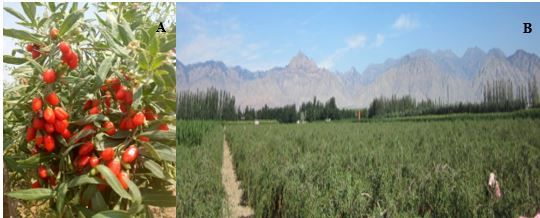
Credit: Yuwang Luan, Yinchuan, Ningxia, China
This crop can be grown in Plant Hardiness Zones 4b to 9b as defined by the US Department of Agriculture (USDA) (Figure 2). Therefore, most of Florida's climate is favorable for goji berry, and a few Florida growers have cultivated it for years. This species can tolerate infertile and unfavorable growth conditions and hence can be mistakenly considered invasive, but FDACS DPI (Florida Department of Agricultural and Consumer Services, Division of Plant Industry) botanists in Gainesville, Florida, have concluded that goji is not an invasive species (Alex de la Paz, personal communication). The prominent health benefits of this crop may be highly profitable for Florida growers. The objective of this article is to provide a general overview of how the goji berry can be grown in Florida.

Goji berry is a deciduous woody shrub that can naturally reach 12 feet tall with a spread of approximately 4 feet. Cultivated goji berry shrubs are typically 3 to 6 feet tall due to periodic pruning. The long stems have a yellow-brown skin (A and B in Figure 3). The stem is branched with 0.2-to-0.4-inch thorns. The branches are slender, gradually curving and drooping like a weeping willow (Figure 3A). The grayish leaves are commonly ovate- to lanceolate-shaped, measuring between 0.6 and 0.7 inches in both length and width, and are somewhat succulent (B in Figure 3). The purplish flowers bloom from June to September and are followed by setting green berries that turn scarlet or orange-red as they mature from August to October (C and D in Figure 3) (Cui and Wang 2000).
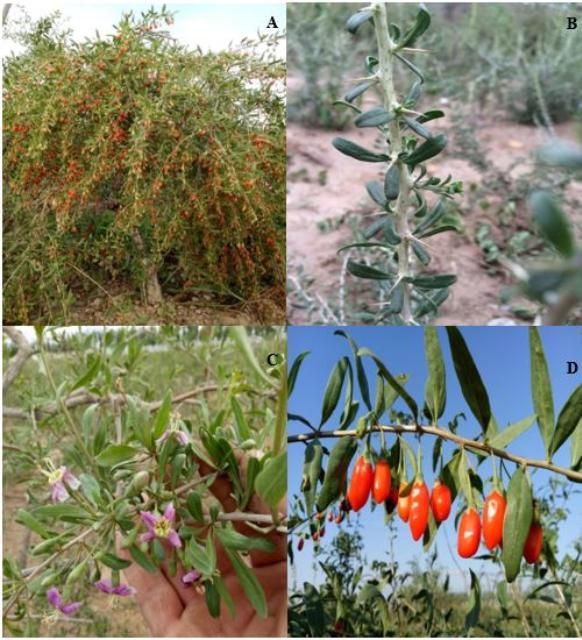
Credit: Manhe Jiao, Yinchuan, Ningxia, China
Species
There are ten Eurasian Lycium species. Among them, seven have been domesticated (Zheng et al. 1994). The two most popular in China are Lycium barbarum Linné (in Chinese: Chinese wolfberry, Barbary wolfberry, or Chinese boxthorn) and Lycium chinense Miller (in Chinese: Gouqi). These two species are significantly different in both morphology and molecular biology (Table 1). Lycium chinense has almost double the seed area in berries than L. barbarum. The chromosome number of Lycium barbarum is 24 (Chen et al. 2018) but that of Lycium chinense is in a range from 24 to 48 (Li 1989). Both species have a long history of food and medicinal values in China and other Asian countries. Lycium barbarum was named by Carl Linnaeus in 1753, whereas Lycium chinense was named by Philip Miller in 1768 (Kulczynski and Gramza-Michalowska 2016). Lycium barbarum is 10 to 12 feet tall, while L. chinense is somewhat smaller. Lycium chinense berry is less sweet than Lycium barbarum (Lee et al. 2014), and its leaves are more rounded. Lycium chinense is mainly distributed in East Asia and grown in Korea, Japan, and south China, and it is currently cultivated in USDA Hardiness Zones 6–9 (USDA NRCS 2006). Lycium barbarum is the most widely grown species, mainly grown in north-central and western China. This crop can grow in USDA Hardiness Zones 4–9 (Zhang et al. 2001).
Planting
Goji berry is adaptable to most climates but grows best in full sun (Spurrier 2013). Florida's climate is suitable for goji berry production. The crop grows well in warm climates, with average monthly temperatures of 59°F to 68°F being best for growth. When the temperature is around 45°F, the goji berry seeds can germinate, and the seedlings can withstand a low temperature of 27°F. When the temperature is above 43°F in spring, the spring buds start to sprout.
Goji berry grows mostly on sandy and loam soils. This crop can grow in a broad range of soil pH, but pH 6.8–8.1 is optimal. It is also suitable for arid areas because it has a developed root system and can tolerate drought stress (Zhang et al. 2012).
Goji berry propagation can be started from seeds or cuttings, but cuttings are the most common and easiest way to propagate. Goji berry is new to most Floridians but has already been grown in other areas throughout the United States. Goji berry seedlings may be available for growers to order in such states as New York.
Goji berry in-row plant spacing is 3 to 5 feet apart, with between-row spacing of 6 to 8 feet (1,089–2,420 plants per acre). There are two ways to grow goji berry. First, like raspberry, goji berry can be grown in containers as an ornamental plant. Goji berry develops a deep taproot, so the container size should be at least 5 gallons. The second method is to plant goji berry directly in the ground.
Irrigation
Plants can be watered with sprinkler, micro sprinkler, or drip-irrigation systems. Drip irrigation is the most efficient method because it is subject to less evaporation; irrigation water is delivered directly and gently to the root zone; and water runoff is substantially reduced. Drip irrigation also reduces weeds and discourages pests and diseases (Maughan 2015).
To obtain high berry yields, it is necessary to ensure appropriate water supply, especially during the period of blooming and fruit-setting. Irrigation management of goji berry depends on plant size, soil type, and time of year. Generally, large shrubs require more water than small ones, and sandy soils require more water than clay soils. Goji berry sets and develops berries in summer when irrigation frequency is greater than in spring and fall. Goji berry is susceptible to waterlogging and should not be planted in lowlands that do not drain well. Soil water content for optimal growth ranges from 60% to 70% of field capacity. In general, approximately 1 inch of irrigation water per week may be sufficient, but the recommended irrigation rate is based on historical evapotranspiration (ET) records at local weather stations (Zhang et al. 2012).
Fertilization
Goji berry belongs to the same family as tomato (Solanaceae), and its cultural and nutritional needs are somewhat similar. Goji berry grows best on fertile soils. Fertilizers have the greatest impact on goji berry growth when applied in springtime. Especially beneficial is nitrogen fertilizer, followed by phosphate and potassium. Recommended nitrogen fertilizers include urea, ammonium sulfate, ammonium nitrate, and UAN-32 (50% urea and 50% ammonium nitrate). Recommended phosphate fertilizers include triple superphosphate and double superphosphate. Recommended potassium fertilizers include potassium sulfate and potassium chloride. Adding organic materials and compost to sandy and loam soils may help the soil better retain moisture and nutrients and improve the soil environment by reducing the need for the excessive application of chemical fertilizers. In addition, the Solanaceae fertilizer recommendations based on soil testing for other Solanaceae crops are likely to work well for goji berry.
Pruning
One of the most important reasons for pruning is to form a productive canopy structure and ensure sufficient light for maximum stem growth (Zhang et al. 2012). Although little research on this crop has been conducted for optimal pruning in the United States, practices from other areas can be followed. The goji berry plant does not need to be pruned in the first year. Not pruning can result in more fruits and stronger roots for year 1. However, in other planted areas, the crop is usually pruned to one single main stem in the second year by letting the largest healthy stem grow for a main trunk and pruning all others from 0 to 12 inches above the ground. Cut off the tip carefully to accelerate the side-branch growth when the main trunk reaches 16–18 inches. The pruning in the second year is to trim off spindly stems, remove dead and damaged branches, improve plant shape, and shorten branches in early spring. In late spring, pruning should be done to accelerate top growth and encourage formatting a desired canopy to any of the following shapes: the umbrella model, the three-level model, or the cylindrical model (Figure 4). In summer, trim all new shoots from the main trunk. Keep 3 to 5 strong side shoots growing less than 45 degrees from the main stem. These side shoots will bear some fruit. Leave a strong and upward-growing shoot at the very top of the main trunk stem. This shoot will be the main stem for the coming year.
In the third year, clean unwanted stems in winter, and control structure and canopy growth in summer. New shoots will grow at those points where large branches are trimmed. This new growth will be the most fruitful stems. Remove all new shoots around the base of the truck because they do not bear fruit. Additionally, root sprouts appearing in the ground near the plant need to be pulled out and can be replanted elsewhere if desired. For all further pruning activities, shape the plant into a nice canopy approximately 6 feet tall and 3 feet in diameter. Always maintain a one-foot clearance from the ground.

Credit: Yujie Jiao
Diseases and Pest Management
Netting the crop can prevent birds or squirrels from foraging berries. Fencing can keep rabbits and deer away from the leaves and young stem shoots. The main diseases occurring on goji berry include powdery mildew, runny gum disease, and root rot. Spraying 2% copper sulfate solution once a week helps protect against runny gum disease. In addition, good air circulation also prevents powdery mildew from infection (Li et al. 2006). Goji berry hosts pests such as aphids, goji berry mites, and goji berry leaf beetles, which all may be controlled chemically. Spraying agricultural soap on the leaves is also effective to control aphids (Li et al. 2006). Please contact your local Extension office for more information about disease and pest management.
Harvest and Use
In China, the goji berry harvest period begins in August and ends in October. Plants grown in California first bloom in late spring to early summer, and berries begin to ripen in midsummer. Berries can be harvested when they turn red or orange (Figure 5A, B; Figure 6A, B) and the peduncle loosens (Figure 7). With ambient temperatures ranging from 68°F to 77°F, the berries can be harvested once every 10–15 days, up to 8–10 times a year (Cui and Wang 2000). Maximum yields are approximately 7000 lb/acre in China (Cui and Wang 2000). Currently, harvest is by hand for both fresh and processed consumption. Fresh goji berries can be stored at room temperature for approximately one week or in the refrigerator for a couple of weeks. For processing, the freshly picked berries are dried by spreading them out in a thin layer at room temperature. After drying for 2 to 3 days, the fruit become wrinkled and are then moved to finish drying in the sun (Figure 5B). Turning over or stirring should be avoided during the drying process to avoid discoloration. Dried goji berries can be stored in a dark, dry, cool place for at least one year. Fresh berries can be dried if left at room temperature too long.
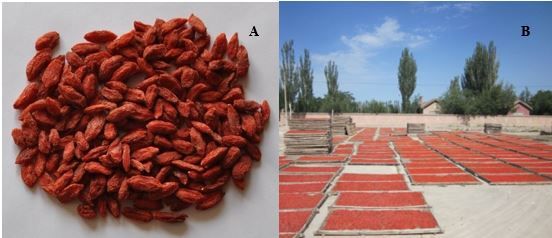
Credit: Manhe Jiao, Yinchuan, Ningxia, China
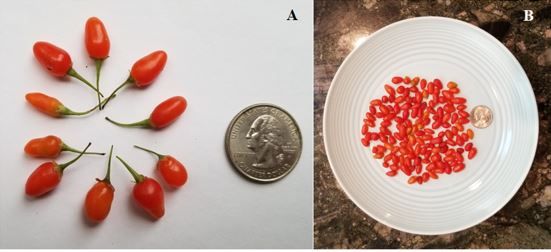
Credit: Guodong Liu, UF/IFAS
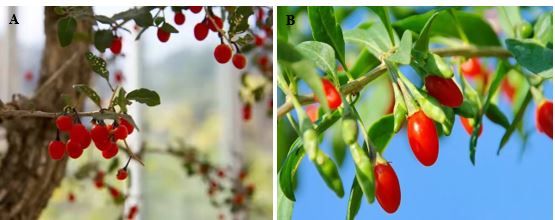
Credit: Zhifu Zhang, Baiyin, Gansu, China
Nutraceutical Uses
Goji berry fruit contains at least 355 physiologically active compounds, such as alkaloids, steroids, terpenoids, flavoids, phenylpropanoids, glycerogalactolipids, coumarins, and antraquinones. The fruit is a promising nutraceutical food with pharmaceutical effectiveness because of the above active compounds and high vitamin and mineral (Fe, Zn, Cu, etc.) contents, including B vitamins (B1, B2, B6), vitamin C, essential amino acids, linoleic acid, polysaccharide, and carotenoid (Table 2; Potterat 2010). Approximately 5%–8% of the dry weight of goji berry consists of Lycium barbarum polysaccharides (LBP) or glycoconjugate.
Both fresh and dried goji berries have many reported health benefits, including boosting the immune system and flu protection (Ren et al. 2012), preventing fatigue, antiaging, relieving headaches and insomnia, improving circulation and weight loss, protecting the retina and improving vision, protecting the liver and kidneys, reducing blood pressure and cholesterol, preventing cancer and cardiovascular disease (Sun et al. 2017), and preventing neurodegeneration in Alzheimer's disease (Chang et al. 2010). Many physiologically active ingredients, such as polysaccharides, flavonoids, carotenoids, vitamins, and minerals, provide health-enhancing effects (Kocyigit and Sanlier 2017; Figure 8A).
While goji berry is a medicinal and pharmaceutical food, it is also a common ingredient in oriental cuisines. The plant's leaves are edible as a potherb, the bark can be used in teas, and the vitamin-rich berries are eaten fresh, dried, and as jellies and juices. The berries taste sweet and sour. Both fruit and leaves may also be served with green tea (Figure 8B), alcoholic beverages, yogurt (Figure 8C), vegetable and meat dishes, rice gruel, and porridge.
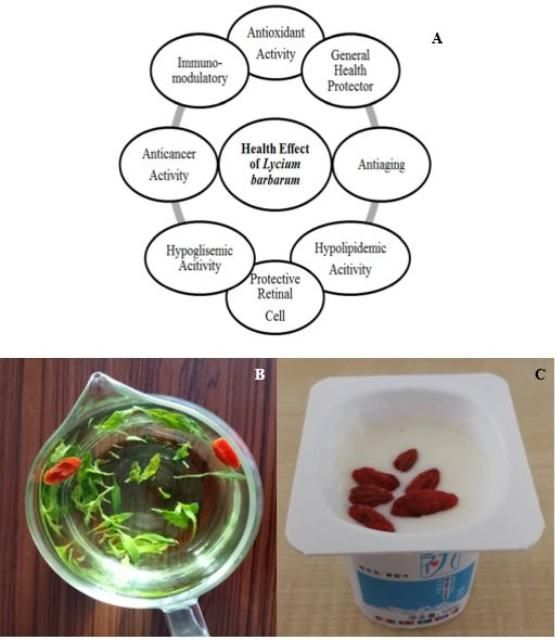
Credit: Liben Wei and Xueqiang Jing, Yinchuan, Ningxia, China
Summary
Goji berry is a deciduous woody shrub cultivated in many countries. This cash crop is suitable to be planted on sandy and loam soils, grows well in warm climates, and prefers fertile soil. The berry can be eaten either fresh or dried, and it is nutritious, beneficial for human health, and commonly used as an ingredient in Asian cuisines. The environment in north and central Florida is very suitable for the growth of goji berry based on the current research results and production experiences in other areas. In Florida, goji berry also needs its own BMPs for fertilization and irrigation; disease, pest, and weed control; and commercial cultivation and home gardens.
Acknowledgments
This work is supported in part by the China Scholarship Council for International PhD Programs. Dr. Edward Hanlon, emeritus professor, Ms. Mary Dixon, Mr. Jonathan Denson, and Ms. Thioro Fall at UF reviewed the manuscript. Alex de la Paz, FDACS-DPI, confirmed goji's noninvasiveness in Florida.
References and Further Reading
Chang, R. C. C., Y. S. Ho, M. S. Yu, and K.F. So. 2010. "Medicinal and nutraceutical uses of wolfberry in preventing neurodegeneration in Alzheimer's disease." Recent Advances on Nutrition and the Prevention of Alzheimer's Disease 201:169–185. https://pdfs.semanticscholar.org/84ad/4694613114e9592b5f388346e9204c040048.pdf. Accessed January 16, 2024.
Chang, S. K., C. Alasalvar, and F. Shahidi. 2018. "Superfruits: Phytochemicals, antioxidant efficacies, and health effects—A comprehensive review." Critical Reviews in Food Science and Nutrition 59 (10): 1580–1604. https://doi.org/10.1080/10408398.2017.1422111. Accessed January 16, 2024.
Chen, J., C-C. T. Chao, and X. Wei. 2018. "Gojiberry breeding: current status and future prospects." In Breeding and Health Benefits of Fruit and Nut Crops, edited by J. Soneji and M. Nageswara-Rao. London: IntechOpen. 3–20. https://doi.org/10.5772/intechopen.76388 Accessed January 16, 2024.
Cui, A. P., and N. S. Wang. 2000. "Value of Lycium chinese and its cultural techniques." Shanxi Forestry Science and Technology 4:31–34.
Himelrick, D. 2018. "Growing goji berries, the latest superfruit." https://www.lsuagcenter.com/profiles/truffin/articles/page1529524613219. Accessed January 16, 2024.
Homer, B. 2017. "Growing goji berries aka wolfberry (Lycium barbarum)." https://ucanr.edu/blogs/blogcore/postdetail.cfm?postnum=25333. Accessed January 16, 2024.
Kocyigit, E., and N. Sanlier. 2017. "A review of composition and health effects of Lycium barbarum." International Journal of Chinese Medicine 1 (1): 1–9. DOI: 10.11648/j.ijcm.20170101.11. https://www.sciencepublishinggroup.com/journal/paperinfo.aspx?journalid=283&doi=10.11648/j.ijcm.20170101.11. Accessed January 16, 2024.
Kulczynski, B., and A. Gramza-Michalowska. 2016. "Goji berry (Lycium barbarum): Composition and health effects—a review." Polish Journal of Food and Nutrition Sciences 66 (2): 67–76. https://doi.org/10.1515/pjfns-2015-0040. Accessed January 16, 2024.
Lee, H. W., Y. H. Kim, Y. H. Kim, G. H. Lee, and M. Y. Lee. 2014. "Discrimination of Lycium chinense and Lycium barbarum by taste pattern and betaine analysis." International Journal of Clinical and Experimental Medicine 7 (8): 2053–2059.
Li, R. 1989. Studies on Karyotypes of Vegetables in China. Wuchang, China: Wuhan University Press. 291.
Li, Y., W. S. He, X. J. Zhang, and J. H. Luo. 2006. "Progress in research on the soil fertility and fertilization techniques of Lycium barbarum plantation." Journal of Agricultural Sciences 27 (2): 62–65.
Maughan, T. 2015. "Goji in the Garden." https://digitalcommons.usu.edu/cgi/viewcontent.cgi?referer=&httpsredir=1&article=1775&context=extension_curall. Accessed January 16, 2024.
McAdam, D. 2007. "Goji berries: The new superfruit." The Telegraph, October 12, 2007. https://www.telegraph.co.uk/gardening/3344996/Goji-berries-The-new-superfruit.html. Accessed January 16, 2024.
Nelson, V. 2008. "Wolfberries pack nutrition, but shrubs are invasive." https://www.oregonlive.com/hg/2008/08/vern_nelsonwolfberries_readily.html. Accessed January 16, 2024.
Potterat, O. G. 2010. "Goji (Lycium barbarum and L. chinense): Phytochemistry, pharmacology and safety in the perspective of traditional uses and recent popularity." Planta Medicinal 76 (1): 7–19. https://www.thieme-connect.com/products/ejournals/abstract/10.1055/s-0029-1186218. Accessed January 16, 2024.
Redgwell, R. J., D. Curti, J. Wang, J. M. Dobruchowska, G. J. Gerwig, J. P. Kamerling, and P. Bucheli. 2011. "Cell wall polysaccharides of Chinese Wolfberry (Lycium barbarum): Part 1. Characterisation of soluble and insoluble polymer fractions." Carbohydrate Polymers; 84 (4): 1344–1349.
Ren, Z. H., L. X. Na, Y. M. Xu, M. Rozati, J. P. Wang, J. G. Xu, C. H. Sun, K. Vidal, D. Y. Wu, and S. N. Meydani. 2012. "Dietary supplementation with lacto-wolfberry enhances the immune response and reduces pathogenesis to influenza infection in mice." The Journal of Nutrition 142 (8): 1596–1602. https://academic.oup.com/jn/article/142/8/1596/4743513?login=false. Accessed January 16, 2024.
Spurrier, J. 2013. "Goji berry: Plant your own backyard superfruit." Los Angeles Times, April 23, 2013.https://www.latimes.com/home/la-xpm-2013-apr-23-la-lh-goji-berry-plants-20130422-story.html. Accessed January 16, 2024.
Sun, Y. J., J. Rukeya, W. Y. Tao, P. L. Sun, and X. Q. Ye. 2017. "Bioactive compounds and antioxidant activity of wolfberry infusion." Scientific Reports 7:40605. https://www.nature.com/articles/srep40605. Accessed January 16, 2024.
USDA, ARS. 1953. "Lycium barbarum." Germplasm Resources Information Network (GRIN). https://npgsweb.ars-grin.gov/gringlobal/taxonomydetail.aspx?id=22939. Accessed January 16, 2024.
USDA, NRCS. 2020. The PLANTS Database. National Plant Data Team, Greensboro, NC 27401-4901 USA. http://plants.usda.gov. Accessed January 16, 2024.
Wang, Y., H. Chen, M. Wu, S. Zeng, Y. Liu, and J. Dong. 2015. "Chemical and genetic diversity of wolfberry." In Lycium barbarum and Human Health, edited by R. C. C. Chang and K. F. So. 1–26. Berlin: Springer.
Zhang, K. Y. B., H. W. Leung, H. W. Yeung, and R. N. S. Wong. 2001. "Differentiation of Lycium barbarum from its related Lycium species using random amplified polymorphic DNA." Planta Medica 67 (4): 379–381. https://doi.org/10.1055/s-2001-14310. Accessed January 16, 2024.
Zhang, W., J. P. Tan, M. C. Ma, Z. C. Xu, and S. W. Xu. 2012. "The harmless culture techniques of Lycium barbarum." Science and Technology of Qinghai Agriculture and Forestry 4:58–59.
Zheng, Y. W., and P. Raven. 1994. Flora of China: Verbenaceae through Solanaceae. Volume 17. Beijing: Science Press. 378.